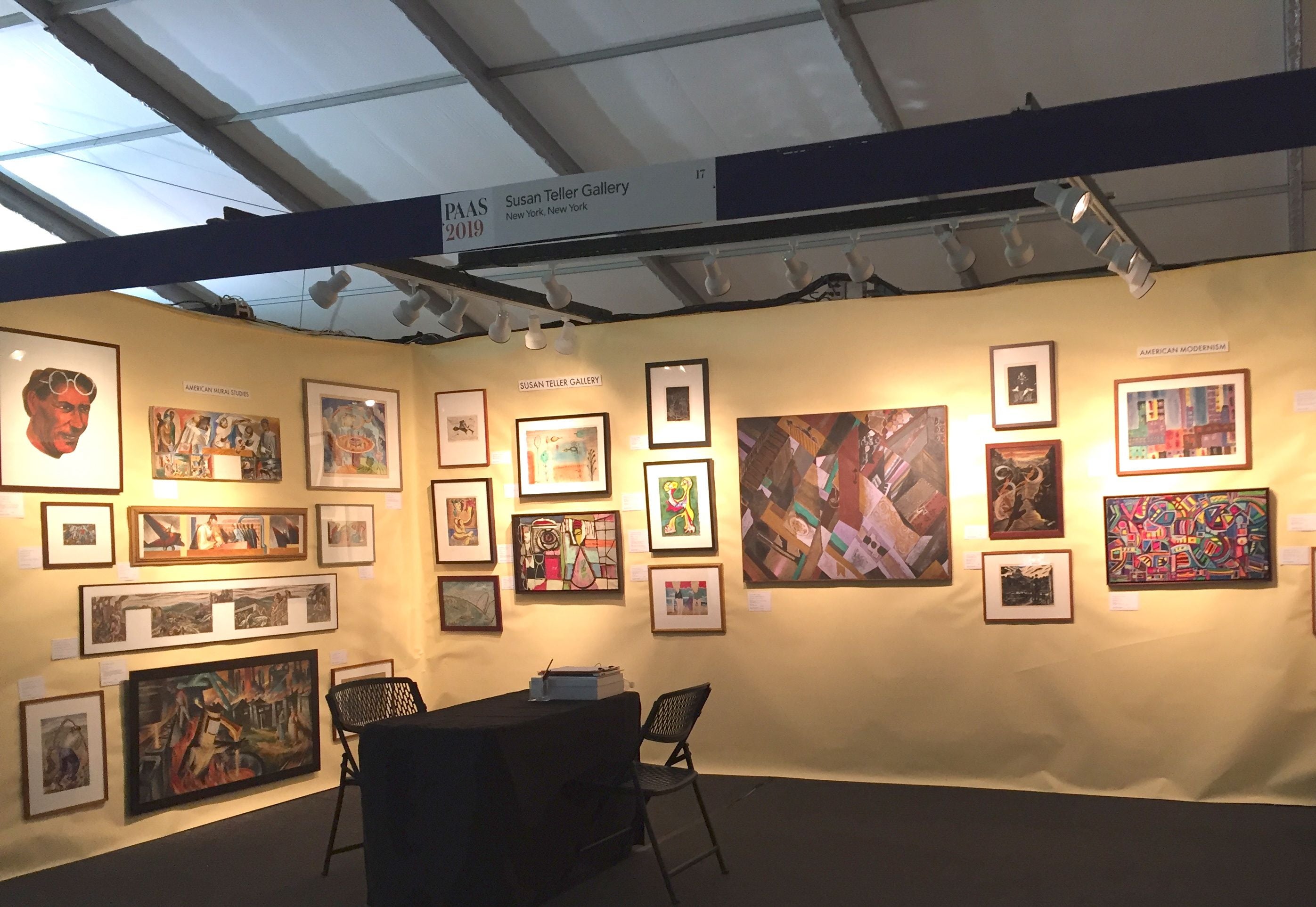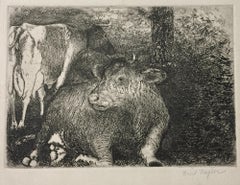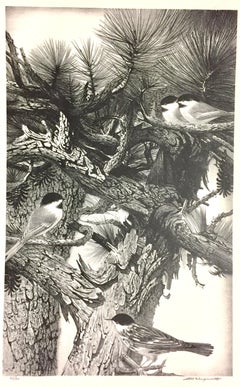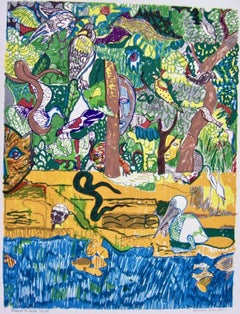Want more images or videos?
Request additional images or videos from the seller
1 of 5
Fred NaglerFred Nagler, (Cows in a Pasture, small version)1925
1925
Price:$297
$350List Price
About the Item
- Creator:Fred Nagler (1891-1983, American)
- Creation Year:1925
- Dimensions:Height: 4.63 in (11.77 cm)Width: 5 in (12.7 cm)
- Medium:
- Movement & Style:
- Period:
- Condition:Good condition. No problems.
- Gallery Location:New York, NY
- Reference Number:1stDibs: LU141027958142

About the Seller
4.9
Gold Seller
Premium sellers maintaining a 4.3+ rating and 24-hour response times
Established in 1988
1stDibs seller since 2020
129 sales on 1stDibs
Typical response time: 5 hours
Authenticity Guarantee
In the unlikely event there’s an issue with an item’s authenticity, contact us within 1 year for a full refund. DetailsMoney-Back Guarantee
If your item is not as described, is damaged in transit, or does not arrive, contact us within 7 days for a full refund. Details24-Hour Cancellation
You have a 24-hour grace period in which to reconsider your purchase, with no questions asked.Vetted Professional Sellers
Our world-class sellers must adhere to strict standards for service and quality, maintaining the integrity of our listings.Price-Match Guarantee
If you find that a seller listed the same item for a lower price elsewhere, we’ll match it.Trusted Global Delivery
Our best-in-class carrier network provides specialized shipping options worldwide, including custom delivery.You May Also Like
Trumpet Flowers and Playing Dogs, monochromatic black and white
By Jenny Toth
Located in Brooklyn, NY
This is a one of a kind aquatint printed in rich blacks. The image is 12 x 12 and is printed on a 20 x 20 piece of paper. The image depicts large trumpet flowers in a garden with d...
Category
2010s Contemporary Landscape Prints
Materials
Paper, Ink, Etching, Aquatint
$900
H 20 in W 20 in D 0.5 in
Concerning the Great Ship MOUR-DE-ZENCLE — Framed Etching by David Avery
By David Avery
Located in Palm Springs, CA
Description
David Avery’s Concerning The Great Ship MOUR-DE-ZENCLE is a finely detailed black-and-white etching that exemplifies the artist’s masterful command of line and surreal symbolism. Avery frequently blends mythology, literary reference, and historical imagery, and here he draws inspiration from Alfred Jarry...
Category
2010s Contemporary Animal Prints
Materials
Etching
A Burro Train, New Mexico
By Peter Moran
Located in Middletown, NY
Etching with aquatint on heavy laid paper, 7 x 9 1/4 inches (172 x 233 mm), full margins. Signed in the plate, lower right image area. Minor corner loss, top right, and a 1/4 inch ed...
Category
Late 19th Century American Realist Animal Prints
Materials
Laid Paper, Etching
Geese, by Stephen McMillan
By Stephen McMillan
Located in Palm Springs, CA
Medium: etching and aquatint
Edition of 250
Year: 2014
Image Size: 9 x 12 inches
Signed, titled and numbered by the artist.
Inspired by a scene of seven Canadian Geese in Lake Padde...
Category
2010s Contemporary Landscape Prints
Materials
Etching, Aquatint
17th century etching Rembrandt landscape house trees field sky cow
By Rembrandt van Rijn
Located in Milwaukee, WI
This piece is from a collection of originally designed etchings with drypoints by Rembrandt. It is printed on Ingres D'arches off-white laid paper. The prints are the sixth and final state Posthumous Impression. Printing plates were made in 1650, this collection was printed in 1998.
Rembrandt van Rijn was one of the masters of the landscape genre in his prints and drawings. In his etching, "Landscape with a Cow...
Category
17th Century Renaissance Landscape Prints
Materials
Etching
$7,540 Sale Price
20% Off
H 19 in W 20 in
Two Horses
By Kaiko Moti
Located in San Francisco, CA
This artwork "Two Horses" 1964, is an original color aquatint on paper by noted Indian artist Kaiko Moti, 1921-1989. It is hand signed and numbered 107/120 in pencil by the artist. ...
Category
Mid-20th Century Impressionist Animal Prints
Materials
Aquatint
Lakeshore, landscape by lake, by Trevor Southey
By Trevor Southey
Located in Palm Springs, CA
Signed, titled and numbered by the artist from an edition of 60. Nostalgic scene of a lakeshore cabin with boat.
Trevor Southey was born in Rhodesia, Africa (now Zimbabwe) in 1940....
Category
1980s Contemporary Landscape Prints
Materials
Etching, Aquatint
Island Light, by Stephen McMillan
By Stephen McMillan
Located in Palm Springs, CA
Medium: etching and aquatint
Edition of 120
Year: 2023
Image Size: 4 x 5 inches
Signed, titled and numbered by the artist.
The view west from Cypress Island off the coast of Washin...
Category
2010s Contemporary Landscape Prints
Materials
Etching, Aquatint
Salvador Dali, Le Cerf Malade Signed Etching Engraving, Color Lithograph Pochoir
By Salvador Dalí
Located in Surfside, FL
An original signed drypoint etching with color pochoir by Spanish artist Salvador Dali titled "La Cerf Malade", depicting a stag deer, from the Portfolio: Le Bestiaire de la Fontaine...
Category
1970s Surrealist Animal Prints
Materials
Color, Drypoint, Etching
$3,600
H 35.5 in W 27.75 in
Dog and Snipe original signed limited edition etching by Leon Danchin
By Leon Danchin
Located in Paonia, CO
Leon Danchin, born in Lille, France in 1887 began his career as an artist at the age of sixteen when he was accepted by the Salon des Artists in Paris. He eventually became known as ...
Category
20th Century Realist Animal Prints
Materials
Etching
$850
H 25.75 in W 19.75 in
More From This Seller
View AllFred Nagler, (Cows in a Pasture)
By Fred Nagler
Located in New York, NY
Massachusetts-born Fred Nagler studied at the Art Students League from 1914 to 1917, with George Bridgeman and Robert Henri, and eventually became a member of the Board of Control. He taught at the Connecticut College for Women, and after the death of Grant Wood, the University of Iowa State...
Category
1920s Ashcan School Animal Prints
Materials
Etching
Christian Ludwig Martin, Geese
Located in New York, NY
Christian Ludwig Martin worked in Vienna. He was an artist, illustrator, and art teacher. 'Geese' is titled in German, and titled and signed in pencil. It is on a large sheet.
While ...
Category
1920s Modern Animal Prints
Materials
Etching
Stow Wengenroth, Friendly Neighbors (Birds)
By Stow Wengenroth
Located in New York, NY
Edition of 80. Signed and numbered in pencil. Really, no one could draw on a lithographic stone like Stow Wengenroth. He drew many animals and birds...
Category
Mid-20th Century Naturalistic Landscape Prints
Materials
Lithograph
Romare Bearden, Dreams of Exile (Green Snake), 1971, by African-American, signed
By Romare Bearden
Located in New York, NY
A North Carolina native, the African-American Romare Bearden spent most of his career in New York City. For several decades he was a social worker in Harlem. But of course he traveled widely, read and studied with great care, and created a phenomenal body of work.
This 1971 lithograph is a good example of his oeuvre -- far reaching though it may be. It speaks to his skill and knowledge of contemporary printmaking while featuring a complex subject representative of his interests.
A lush jungles is packed with flora and fauna. 'Green Snake' is part of the title and there is a particularly winsome reptile showing up so well on the sand-colored border between the dense forest and the aquamarine water. There are of course many other land and sea animals showing themselves -- even a curious ginger cat...
Category
1970s Contemporary Animal Prints
Materials
Lithograph
A. Schultz, Riders in Central Park (New York City)
Located in New York, NY
Such an innovative image on the classic 'Riders in the Park' theme! Further, the use of drypoint and the rather direct -- even aggressive -- drawing style, bring it into the German E...
Category
1930s American Modern Landscape Prints
Materials
Drypoint
Minna Citron, Heifer
By Minna Citron
Located in New York, NY
This subject, Heifer, relates to Citron's mural project focusing on the Tennessee Valley Authority.
It is signed, dated, and annotated 'Et...
Category
1930s Ashcan School Animal Prints
Materials
Etching


